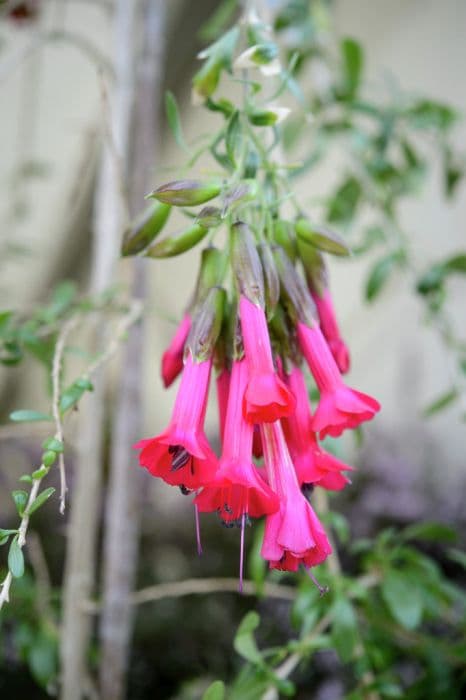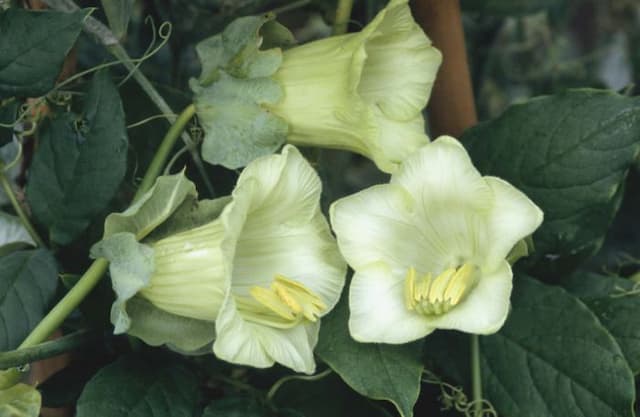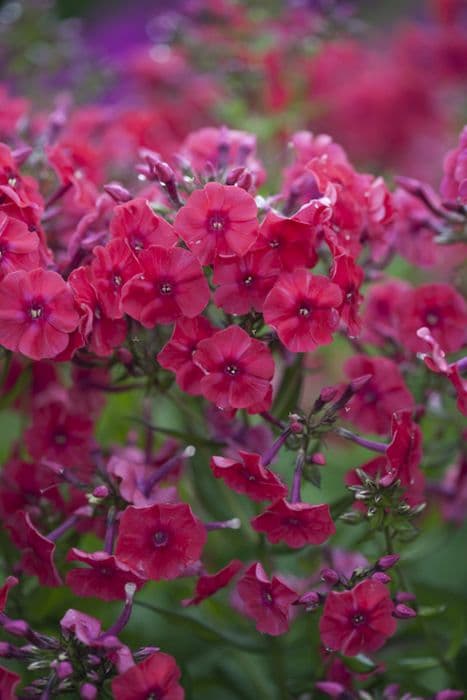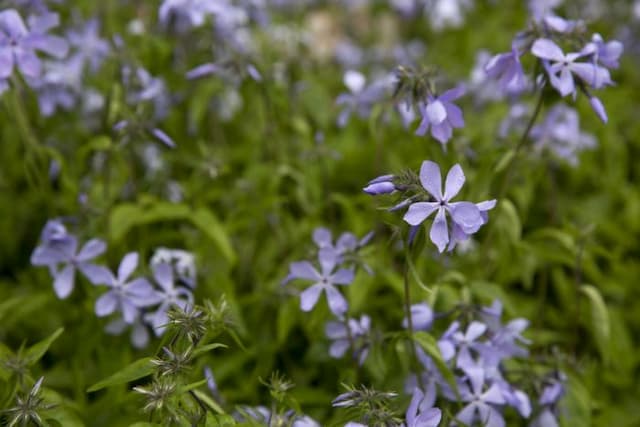Garden Phlox Phlox paniculata 'Düsterlohe'

ABOUT
The garden phlox 'Düsterlohe', often known for its vibrant blooms, features an attractive appearance that makes it a favorite among garden enthusiasts. The flowers of this plant are a striking shade of purple with a faint, almost white, eye at the center, creating a beautiful contrast that can catch the eye from a distance. These blossoms are arranged in dense clusters or panicles, which perch at the top of the stems and create a showy display. The individual flowers are small, tubular, and petal-shaped, contributing to the overall fluffiness of the flower heads. The foliage of 'Düsterlohe' is deep green, providing a lush backdrop for the vivid flowers. The leaves are lance-shaped and may have a slightly glossy finish, which adds texture to the plant's appearance. The stems are sturdy enough to support the weight of the blooms, and the entire plant exudes a classic cottage garden charm. This garden phlox is often visited by pollinators such as butterflies and hummingbirds, drawn to its nectar-rich blooms, which enhances its lively presence in the garden. The plant blooms during the summer months, adding to its appeal as a staple for seasonal color and interest in a variety of garden settings.
About this plant
 Names
NamesFamily
Polemoniaceae
Synonyms
Garden Phlox, Summer Phlox, Fall Phlox, Perennial Phlox, Tall Phlox
Common names
Phlox paniculata 'Düsterlohe'.
 Toxicity
ToxicityTo humans
Garden Phlox is not typically considered toxic to humans. There are no well-documented cases of poisoning from ingesting Garden Phlox. Consequently, touching or ingesting this plant is unlikely to cause any significant or dangerous symptoms. However, as with any plant, individual allergies or sensitivities may cause mild irritation or discomfort.
To pets
Garden Phlox is generally considered non-toxic to pets. It is rare for animals to experience poisoning from consuming this plant. Consequently, ingestion of Garden Phlox is unlikely to result in serious symptoms or long-term consequences for pets. Nonetheless, monitoring pets for any signs of gastrointestinal upset or allergic reaction is always prudent when introducing new plant material into their environment.
 Characteristics
CharacteristicsLife cycle
Perennials
Foliage type
Deciduous
Color of leaves
Green
Flower color
Purple
Height
3-4 feet (0.91-1.22 meters)
Spread
2-3 feet (0.61-0.91 meters)
Plant type
Herb
Hardiness zones
4
Native area
North America
Benefits
 General Benefits
General Benefits- Attracts pollinators: Phlox paniculata 'Düsterlohe', also known as Tall Garden Phlox, is highly attractive to bees, butterflies, and other pollinating insects, which supports biodiversity.
- Long blooming season: This perennial offers a long flowering period through the summer months, providing extended visual interest in the garden.
- Easy to grow: Tall Garden Phlox is known for being a hardy plant that is relatively easy to care for, making it accessible for gardeners of varying experience levels.
- Landscape versatility: It can be used in borders, beds, and as a backdrop for other lower-growing plants, offering structural variety in landscape design.
- Aesthetic appeal: The vibrant and colorful flowers of Tall Garden Phlox can enhance the aesthetic value of any garden or outdoor space.
- Fragrant flowers: The blooms emit a pleasant fragrance that can be enjoyed throughout its growing area, contributing positively to the sensory garden experience.
- Drought tolerance: Once established, Phlox paniculata 'Düsterlohe' can tolerate periods of drought, reducing the need for frequent watering.
- Wildlife habitat: Beyond pollinators, the plant provides a habitat for other wildlife, offering shelter and potential food sources within the ecosystem.
- Cut flowers: The blossoms are suitable for cutting and can be used in arrangements, bringing the garden's beauty indoors.
 Medical Properties
Medical PropertiesThis plant is not used for medical purposes.
 Air-purifying Qualities
Air-purifying QualitiesThis plant is not specifically known for air purifying qualities.
 Other Uses
Other Uses- Phlox can be used to create a natural dye, where the color obtained will depend on the part of the plant used; the flowers typically yield shades of pink or light red.
- The dried petals of phlox can be incorporated into potpourri for a subtle floral fragrance in the home.
- Garden phlox makes an attractive edible garnish due to its colorful flowers, adding a touch of elegance to culinary presentations.
- The stems and foliage of phlox, when included in compost, add valuable nutrients as they break down, thus enriching the soil around them.
- Because of its robust growth, garden phlox can be planted to prevent soil erosion in areas prone to losing topsoil.
- As a natural insect repellent, phlox can sometimes deter certain types of pests when planted in a vegetable garden.
- Garden phlox, when planted in strategic locations, can provide a natural privacy screen or windbreak in the garden space.
- Phlox leaves and flowers can serve as an organic mulch, as they decompose and suppress weed growth while retaining soil moisture.
- Phlox flowers are an excellent choice for butterfly gardens, as they attract pollinators such as butterflies and hummingbirds, promoting biodiversity.
- Dried phlox flowers can be used for crafts, such as in the creation of flower-embedded candles or handmade paper.
Interesting Facts
 Feng Shui
Feng ShuiGarden Phlox is not used in Feng Shui practice.
 Zodiac Sign Compitability
Zodiac Sign CompitabilityGarden Phlox is not used in astrology practice.
 Plant Symbolism
Plant Symbolism- Harmony: Garden Phlox, due to its clustering flowers, symbolizes unity and harmonious blending, representing various aspects of life coming together peacefully.
- Sweet Dreams: It is associated with sweet dreams because of its gentle, soothing fragrance that often lingers in the evening, inviting relaxation and comfort.
- Proposal of Love: Garden Phlox is sometimes included in bouquets or given as a gift to propose affection or express amorous intentions softly.
- Partnership: The dense clusters of the Phlox flowers can symbolize the concept of partnership, with individual blooms standing closely together to make a more substantial collective impact.
 Water
WaterGarden phlox should be watered deeply, making sure the soil is moistened to a depth of at least an inch. This deep watering promotes strong root development. It's best to water this plant early in the morning to allow foliage to dry out during the day, which helps prevent diseases. During the growing season, watering once a week with about one gallon of water per plant should suffice, but the frequency may need to increase during particularly hot or dry periods. Always check the soil moisture before watering; the topsoil should be dry to the touch, but the soil should be moist just below the surface.
 Light
LightGarden phlox thrives in full sun but can tolerate light shade. The ideal spot for garden phlox would receive at least six hours of direct sunlight daily. However, in very hot climates, some afternoon shade can help prevent overheating and fading of the blooms.
 Temperature
TemperatureGarden phlox is a robust perennial that fares best in temperatures ranging between 60°F and 90°F. The plant is hardy and can survive minimum temperatures down to -30°F, ensuring it can endure cold winters. The optimal growing condition for garden phlox is a climate where the temperature does not frequently exceed 90°F, avoiding the stress high heat can cause.
 Pruning
PruningPruning garden phlox is important for maintaining plant health and encouraging vigorous flowering. Deadheading spent flowers promotes further blooming and prevents the plant from self-seeding excessively. Cutting the plant back by one-third in early summer can help to prevent mildew and promote a second, less vigorous round of flowering. The best time for major pruning is late winter or early spring before new growth begins.
 Cleaning
CleaningAs needed
 Soil
SoilGarden Phlox requires well-drained soil enriched with compost or other organic matter. A soil pH of 6.0 to 7.0 is ideal.
 Repotting
RepottingGarden Phlox does not typically require frequent repotting; it is perennial and can be divided every 3 to 4 years to maintain vigor.
 Humidity & Misting
Humidity & MistingGarden Phlox thrives in average outdoor humidity levels without the need for specific humidity adjustments.
 Suitable locations
Suitable locationsIndoor
Use bright light, keep soil moist, and ensure good air circulation.
Outdoor
Plant in sun to part shade, enrich soil with compost.
Hardiness zone
4-8 USDA
 Life cycle
Life cyclePhlox paniculata 'Düsterlohe', commonly known as Garden Phlox, begins its life cycle as a seed which, when sown, germinates in warm, moist soil conditions, usually in spring. Following germination, the seedling emerges and develops into a vegetative state, producing stems, leaves, and roots. As the plant matures, it enters the flowering stage in late spring to early summer, where it produces clusters of fragrant, showy flowers that can attract pollinators such as butterflies and hummingbirds. After pollination, these flowers produce fruit in the form of small capsules containing the seeds, thus concluding the bloom period typically by late summer. As autumn approaches, garden phlox prepare for dormancy; the above-ground portions die back with the onset of colder weather, but the roots remain alive and store energy for the next growing season. The cycle resumes the following spring, when new growth emerges from the perennial rootstock, continuing the life cycle of the plant.
 Propogation
PropogationPropogation time
Spring to early summer
Propogation: For Phlox paniculata 'Düsterlohe', also known as Garden Phlox, the most popular method of propagation is by root cuttings. This process involves carefully digging up a portion of the plant's root system during its dormancy in late autumn or early winter. Select healthy roots, about the thickness of a pencil (approximately 1/4 to 1/2 inch or 6 to 12 mm in diameter), and cut them into sections 2 to 3 inches (5 to 7.6 cm) long. These cuttings should then be planted horizontally in a mix of sand and peat, placed in a cold frame or a similar protected environment. Once rooted, typically by spring, they can be potted up individually before eventually being transplanted into the garden. This method maintains the characteristics of the 'Düsterlohe' cultivar, ensuring the new plants will have the same traits as the parent.









